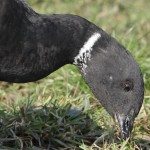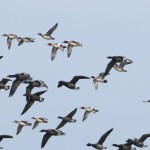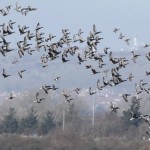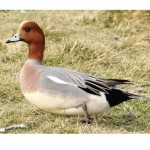After a stormy, wet and windy Friday night, we set off for Farlington Marshes at first light on the morning of Saturday 10 January. It was a balmy 12 degrees C with constantly driven horizontal rain. But the weather forecast correctly predicted that it would clear up as the morning progressed, with a fast and active cold front passing quickly through. After donning all the waterproofs, we assembled in the carpark at 9.30am in buffeting winds and quite low light levels. Undeterred, our group of 7 hardy and seasoned members set off in high hopes and low expectations. Frustrating glimpses of Linnets in the weedy car park borders and a ghostly adult Mediterranean Gull effortlessly gliding into the strong head wind [as gulls do] across the low tide mudflats was an encouraging start. Within minutes we were admiring close and confiding families of Russian Dark-bellied Brent Geese which were grazing the abundant intertidal algae. The juveniles could be distinguished by their pale-edged wing coverts. On the banks of the freshwater outlet on the western edge of the mudflats a tightly knit flock of eighty Avocets were reluctant to settle. We progressed towards the reserve and found a charming male Stonechat flitting down onto the exposed seaweed and back, enticed perhaps by the surprising numbers of Starlings feeding on invertebrates amongst the Brent Geese and piles of Bladder Wrack seaweed.
No sooner had we passed through the reserve entrance kissing gate than the heavens opened ! We picked our way through the hawthorn scrub to the only cover available, a small utility building in the N.E. corner of the reserve. But almost immediately the rain eased off, and this allowed us to view a small group of Black-tailed Godwits and Teal on a nearby pool margin.
As the wind perceptibly eased and the warm glow of winter sunshine made a welcome presence, the song from a couple of Cetti’s Warblers burst out from the nearby reed beds. We made our way eastwards past small groups of Brents grazing in the meadows of quite long grass – too long to find any coloured leg rings adorning the bird’s ankles. In 2009 I photographed a colour-ringed Brent Goose “LVB=” at Farlington which had been ringed as a gosling on the Taymyr Peninsula at 89 degrees East, 77 degrees North, one quarter of the way around the world.
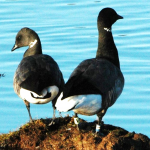
Brent Goose “ LVB=”,
28 Dec 2009 Farlington
Ringed as gosling 89E, 77 N
A Kestrel hovered almost motionless in the distance. As we approached the sea wall, large areas of mud flat and seaweed remained uncovered by the incoming tide; huge numbers of Brent Geese, Wigeon , Shelduck, Pintail, Curlew and Dunlin were scattered all around, but with many well hidden amongst the mud, weed and shadows. The seemingly nervous Curlew left the mud in droves to join the geese in the security of the grazing meadows of the reserve. As a heavy squally shower passed, forcing us to stand with backs to the wind, the dozens of Dunlin became hundreds, feeding feverishly at the advancing water’s edge. Amongst them Turnstone turned over the flaccid seaweed, and the odd Redshank and Bar-tailed Godwit strutted around. In the distance increasing numbers of waders were swirling around in massed ranks, shimmering light and dark, pushed up by the incoming tide; different flying styles filtered them into separate groups of all Grey Plover, all Dunlin and all Oystercatcher.
Regular parties of Brent Geese, Pintail, Wigeon and Teal in front of us were lifting off the fast disappearing mud, then flying overhead to join the growing flocks on the grazing meadows. Little brown jobs bounced high in the wind off the marsh to join them, eventually settling to reveal the all-dark plumage of Rock Pipits. We finally reached the southernmost point of the reserve and were comforted to find the small south-facing recess in the concrete seawall unoccupied, allowing all of us to duck down out of the wind to have our well-earned packed lunches. As we savoured our sandwiches and hot drinks, more massed ranks of waders swirled around in front of us, sparkling in the very welcome sunshine; the surging tide brought in Great Crested Grebes in their stark winter dress in contrast to Red-breasted Mergansers with the males in their fine breeding colours, and Goldeneye, a female first, diving so frequently as to make ID challenging, and then the splendid male with his guardsman’s bearskin hat and huge white beauty spot came by to complete our lunchtime entertainment.
It was a bit of a shock to stand up into the bracing wind! But the winter light was wonderful and with the sun behind us it was time to scan the grazing meadows. Unusually there was a large flock of roosting Shelduck strung out along the length of one of the many freshwater ponds on the reserve. Any hope of counting them was lost with the excited announcement of one word………. “PEREGRINE”……. followed by “sat on a post in front of the Shelduck” . But better than one, there were two, a larger paler female and a smaller darker, almost blue backed male; sat on the grass and distant, but peregrines indeed.
Now we were well on our way back to the car park, and passed the main pool on the western side of the reserve, which had a constant passage of birds coming in to bathe and desalinate in the freshwater, and then move on. Family groups of Brent Geese took it in turn to fly in and bathe, along with good numbers of Common and Black-headed Gulls. No Bearded Reedlings in the reed beds today as the wind was far too strong for them to show, but relaxed groups of Teal, Pintail, Mallard and Black-tailed Godwits loafed around the edges. As we approached the din of the A27, we had a chance once more to scrutinise the plumages of a couple of Brent Goose families with 2 and 3 young and made the pleasing conclusion that 2014 had been one of their more successful breeding seasons, and that they and the many other birds we found and watched today had given us a most enjoyable and satisfying winter day’s birding on the south coast.
Report by Ken White
Pictures by Ken White
SPECIES LIST FOR FARLINGTON MARSHES
| Great Crested Grebe |
| Cormorant |
| Grey Heron |
| Dark-bellied Brent Goose |
| Canada Goose |
| Shelduck |
| Mallard |
| Teal |
| Gadwall |
| Wigeon |
| Pintail |
| Shoveler |
| Goldeneye |
| Red-breasted Merganser |
| Peregrine |
| Kestrel |
| Moorhen |
| Coot |
| Oystercatcher |
| Lapwing |
| Grey Plover |
| Turnstone |
| Snipe |
| Curlew |
| Black-tailed Godwit |
| Bar-tailed Godwit |
| Redshank |
| Dunlin |
| Avocet |
| Great Black-backed Gull |
| Lesser Black-backed Gull |
| Common Gull |
| Black-headed Gull |
| Mediterranean Gull |
| Wood Pigeon |
| Carrion Crow |
| Rook |
| Magpie |
| Blue Tit |
| Great Tit |
| Blackbird |
| Stonechat |
| Robin |
| Cetti’s Warbler |
| Dunnock |
| Wren |
| Rock Pipit |
| Pied Wagtail |
| Starling |
| Linnet |
List by Ken White


